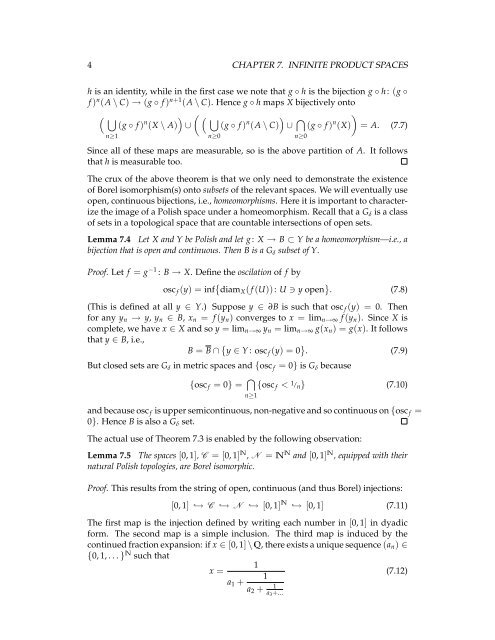You also want an ePaper? Increase the reach of your titles
YUMPU automatically turns print PDFs into web optimized ePapers that Google loves.
4 CHAPTER 7. INFINITE PRODUCT SPACES<br />
h is an identity, while in the first case we note that g h is the bijection g h : (g<br />
f ) n (A \ C) ! (g f ) n+1 (A \ C). Hence g h maps X bijectively onto<br />
⇣ [<br />
(g f ) n ⌘ ✓ ⇣ [<br />
(X \ A) [ (g f ) n ⌘<br />
(A \ C) [ \<br />
(g f ) n ◆<br />
(X) = A. (7.7)<br />
n 1<br />
n 0<br />
Since all of these maps are measurable, so is the above partition of A. It follows<br />
that h is measurable too.<br />
The crux of the above theorem is that we only need to demonstrate the existence<br />
of Borel isomorphism(s) onto subsets of the relevant <strong>spaces</strong>. We will eventually use<br />
open, continuous bijections, i.e., homeomorphisms. Here it is important to characterize<br />
the image of a Polish space under a homeomorphism. Recall that a Gd is a class<br />
of sets in a topological space that are countable intersections of open sets.<br />
Lemma 7.4 Let X and Y be Polish and let g : X ! B ⇢ Y be a homeomorphism—i.e., a<br />
bijection that is open and continuous. Then B is a Gd subset of Y.<br />
Proof. Let f = g 1 : B ! X. Define the oscilation of f by<br />
n 0<br />
osc f (y) =inf diamX( f (U)): U 3 y open . (7.8)<br />
(This is defined at all y 2 Y.) Suppose y 2 ∂B is such that osc f (y) = 0. Then<br />
for any yn ! y, yn 2 B, xn = f (yn) converges to x = limn!• f (yn). Since X is<br />
complete, we have x 2 X and so y = limn!• yn = limn!• g(xn) =g(x). It follows<br />
that y 2 B, i.e.,<br />
B = B \ y 2 Y : osc f (y) =0 . (7.9)<br />
But closed sets are Gd in metric <strong>spaces</strong> and {osc f = 0} is Gd because<br />
{osc f = 0} = \<br />
n 1<br />
{osc f < 1/ n} (7.10)<br />
and because osc f is upper semicontinuous, non-negative and so continuous on {osc f =<br />
0}. Hence B is also a Gd set.<br />
The actual use of Theorem 7.3 is enabled by the following observation:<br />
Lemma 7.5 The <strong>spaces</strong> [0, 1], C =[0, 1] N , N = N N and [0, 1] N , equipped with their<br />
natural Polish topologies, are Borel isomorphic.<br />
Proof. This results from the string of open, continuous (and thus Borel) injections:<br />
[0, 1] ,! C ,! N ,! [0, 1] N ,! [0, 1] (7.11)<br />
The first map is the injection defined by writing each number in [0, 1] in dyadic<br />
form. The second map is a simple inclusion. The third map is induced by the<br />
continued fraction expansion: if x 2 [0, 1] \ Q, there exists a unique sequence (an) 2<br />
{0, 1, . . . } N such that<br />
1<br />
x =<br />
(7.12)<br />
1<br />
a1 +<br />
a2 + 1<br />
a3+...
















